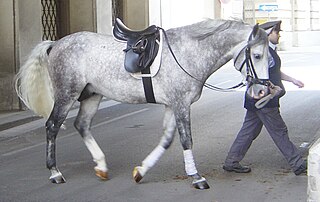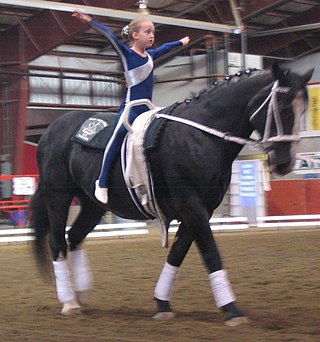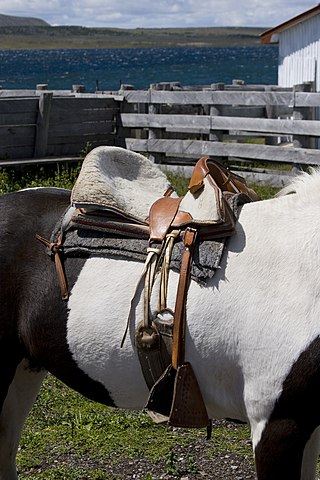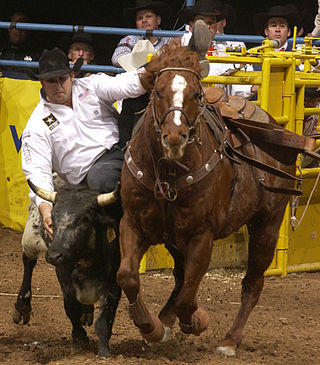Tack is equipment or accessories equipped on horses and other equines in the course of their use as domesticated animals. This equipment includes such items as saddles, stirrups, bridles, halters, reins, bits, and harnesses. Equipping a horse is often referred to as tacking up, and involves putting the tack equipment on the horse. A room to store such equipment, usually near or in a stable, is a tack room.

English saddles are used to ride horses in English riding disciplines throughout the world. The discipline is not limited to England, the United Kingdom in general or other English-speaking countries. This style of saddle is used in all of the Olympic and International Federation for Equestrian Sports (FEI) equestrian disciplines, except for the newly approved FEI events of equestrian vaulting and reining. Most designs were specifically developed to allow the horse freedom of movement, whether jumping, running, or moving quickly across rugged, broken country with fences. Unlike the western saddle or Australian Stock Saddle, there is no horn or other design elements that stick out above the main tree of the saddle.

Western saddles are used for western riding and are the saddles used on working horses on cattle ranches throughout the United States, particularly in the west. They are the "cowboy" saddles familiar to movie viewers, rodeo fans, and those who have gone on trail rides at guest ranches. This saddle was designed to provide security and comfort to the rider when spending long hours on a horse, traveling over rugged terrain.

A bridle is a piece of equipment used to direct a horse. As defined in the Oxford English Dictionary, the "bridle" includes both the headstall that holds a bit that goes in the mouth of a horse, and the reins that are attached to the bit. It provides additional control and communication through rein pressure.

Longeing or lungeing is a technique for training and exercising horses. It is also a critical component of the sport of equestrian vaulting.

A longeing cavesson is a piece of equipment used when longeing a horse. A longeing cavesson consists of a heavy, padded noseband, metal rings to attach the longe line, a throatlatch, and sometimes additional straps such as a jowl strap or a browband for added stability. It is placed on the horse's head in a manner somewhat akin to a halter, but provides significantly more control than a halter, without placing pressure on the horse's mouth as a bridle would. The noseband should be just below the cheekbone, several inches above the nostrils sitting on the nasal bone, and fitted snugly. The jowl strap should be very snug to prevent the cavesson from slipping into the horse's eye.

Side reins are equipment used when longeing a horse, running from the bit of the bridle to the saddle or surcingle. As a horse training tool, they encourage flexion and softness in the horse's mouth. For longe line work with a rider up who does not carry ordinary riding reins, they help calm and settle the animal. However, they are a tool best used by experienced handlers; used improperly they may unduly restrict the horse's movement or cause an accident.

A crupper is a piece of tack used on horses and other equids to keep a saddle, harness or other equipment from sliding forward.
A martingale is any of several designs of tack that are used on horses to control head carriage. Martingales may be seen in a wide variety of equestrian disciplines, both riding and driving. Rules for their use vary widely; in some disciplines they are never used, others allow them for schooling but not in judged performance, and some organizations allow certain designs in competition.

Reins are items of horse tack, used to direct a horse or other animal used for riding. They are long straps that can be made of leather, nylon, metal, or other materials, and attach to a bridle via either its bit or its noseband.

A girth, sometimes called a cinch, is a piece of equipment used to keep the saddle in place on a horse or other animal. It passes under the barrel of the equine, attached to the saddle on both sides by two or three leather straps called billets. Girths are used on Australian and English saddles, while western saddles and many pack saddles have a cinch, which is fastened to the saddle by a single wide leather strap on each side, called a latigo.

A bearing rein, also known as an overcheck or a checkrein, is a piece of horse harness that runs from a point on the horse's back, over the head, to a bit. It is used to prevent the horse from lowering its head beyond a fixed point. A variation called a side check passes beside the ears through loops at the top of the bridle cheekpieces.

Draw reins and running reins are pieces of riding equipment used for training that use the mechanical advantage of a 'single movable pulley' to cause the horse to bring its head down and inward. While a regular rein is the strap that attaches to the bit and is held by the rider, these types of reins slide through the bit ring, adding leverage to the rider's hands and arms, allowing the rider to force the horse's head into a desired position.

A breastplate is a piece of tack (equipment) used on horses. Its purpose is to keep a saddle from sliding back. It is also a safety feature—if the saddle's girth or billets break, a rider may have enough time to stop the horse and dismount before the saddle slips off the animal's back. The breastplate is used on both English and Western saddles. Western riding involving working cattle use a thicker sturdier style than in English riding or Western riding horse shows. A breastplate is most helpful for horses with large shoulders and a flat ribcage. A breast collar as part of a harness is used to pull a load.

A saddle is a supportive structure for a rider of an animal, fastened to an animal's back by a girth. The most common type is equestrian. However, specialized saddles have been created for oxen, camels and other animals. It is not known precisely when riders first began to use some sort of padding or protection, but a blanket attached by some form of surcingle or girth was probably the first "saddle", followed later by more elaborate padded designs. The solid saddle tree was a later invention, and though early stirrup designs predated the invention of the solid tree, the paired stirrup, which attached to the tree, was the last element of the saddle to reach the basic form that is still used today. Today, modern saddles come in a wide variety of styles, each designed for a specific equestrianism discipline, and require careful fit to both the rider and the horse. Proper saddle care can extend the useful life of a saddle, often for decades. The saddle was a crucial step in the increased use of domesticated animals, during the Classical Era.

A horse harness is a device that connects a horse to a horse-drawn vehicle or another type of load to pull. There are two main designs of horse harness: (1) the breast collar or breaststrap, and (2) the full collar or collar-and-hames.
A bitting rig or bitting harness is a training tool for horses that can teach a horse to accept a bridle and bit, and later assist a horse in developing the necessary musculature for a given equestrianism discipline. Generally used in conjunction with training on a longe line, it is most often seen in the training of Saddle seat horses, but also is used by some dressage trainers and as a tool to start horses in driving.

A bitless bridle is a general term describing a wide range of headgear for horses or other animals that controls the animal without using a bit. Direction control may also be via a noseband or cavesson, if one is used. The term hackamore is the most historically accurate word for most common forms of bitless headgear. However, some modern bitless designs of horse headgear lack the heavy noseband of a true hackamore and instead use straps that tighten around a horse's head to apply pressure in various ways. These are often specifically patented and marketed as "bitless bridles", usually referencing a particular type of headgear known as the cross-under, though other designs are sometimes also given similar names.

This is a basic glossary of equestrian terms that includes both technical terminology and jargon developed over the centuries for horses and other equidae, as well as various horse-related concepts. Where noted, some terms are used only in American English (US), only in British English (UK), or are regional to a particular part of the world, such as Australia (AU).

A harness saddle is an element of horse harness which supports the weight of shafts or poles attaching a vehicle to a horse. Like other types of saddle, it lies on the horse's back directly behind the withers, often has an internal supportive framework , and usually is secured on either side by a girth passing beneath the horse. Unlike riding saddles, it is an integral part of the harness and is not used as stand-alone equipment.


















